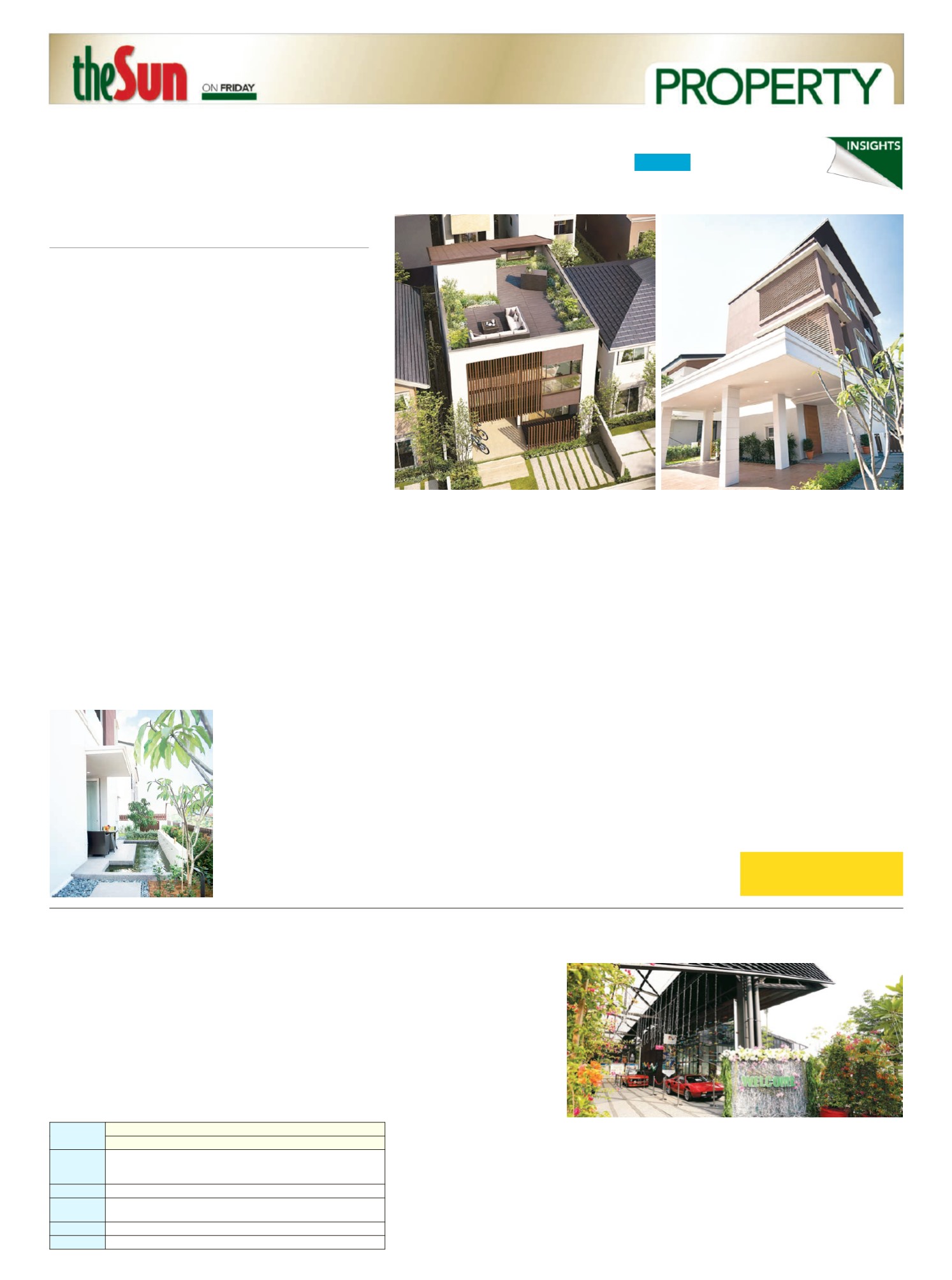

PROS AND CONS
However, Daiwa House chief
certified architect Kanta Tokuda
says that there are
many
advantages in employing the
prefab technique of building
houses. “First and foremost is
the time frame.
Compared to
traditionally built houses, prefab
units only require a short
construction period, less than half
the usual time.” Benefits include:
1) Short construction period -
Whilemodules and panels are
manufactured off site, the
foundation is laid on site,
saving time.
2) Lesser manpower required on site
– According to Tokuda, it only
takes fivemen and threeweeks
to erect themain structure of a
double storey house. It took
four weeks and sixworkers to
assemble the prototype house
in Sunway Eastwood. Basically,
only nuts and bolts need to be
secured once the shell is in place,
besides adjoining electrical
wiring and plumbing.
3) High quality and standardised
workmanship – Quality
controlled uniformity due to
factory-made conditions which
produce productsmade to
specifications. The outcome -
lesser or very fewdefects that
save cost, time, energy etc.
4) Responsible building –
Environmentally friendly in
terms of energy conservation as
lesser manpower is required
with a shorter andmore efficient
construction time frame. There
is also lesser wastematerial on
site. Materials used are also
sustainable (steel and earth-
friendly boards) and depending
on how the home is put together,
some can be dismantled and
re-erected at another location.
AROUND THE GLOBE
Aitchison’s paper reported that
of the 495,737 detached, privately-
owned newhouses constructed in
Japan in 2013, approximately 64,035
(12.9%) were prefab or modular.
It also stated that Sekisui House
produces 15,000 detached houses
per year, and itsmanufacturing
plant in Shizuoka produces
20 houses per day. His take on
Japanese prefab housing: “the
most advanced proponent of its
kind in theworld.
”
His viewon the Australiamarket
– “relatively small but revealsmore
diversity compared to the Japanese
market. Companies likeHappy
Haus, Prebuilt andTektumoffer a
wide range of housing products
which are comparable in price to
Email your feedback and
queries to:
propertyqs@thesundaily.comX
OCTOBER 3, 2014
>Exploring the unconventional process of
acceleratedhouse construction
Prefabricated
housing
G
OING
back about a decade,
whowould have imagined
the speed and connectivity
which internet messaging
allows today. What about the
microwave which permits cooking
and re-heating inminutes, even
seconds? In these fast-paced times
where quick gets quicker in the
blink of an eye, and a newwordmay
need to be coined to describe the
span of time faster than a nano-
second. Houses which took years to
build in an earlier era can nowbe
erected in just a fewmonths.
PREFAB IN GENERAL
Prefab is an abbreviation
for prefabricated
. It is a
relevant
term in the housing industry
referring to prefabricated
housing
. The concept of “prefab
homes” encompass
several
types of building techniques.
Technically, it covers a house
that has sections of the structure
built in a factory and assembled
on site
. Industry professionals
claim that “modular” and “panel
built” houses come under the prefab
label. The difference:
•
Panel building
– Accomplished
by
laying down the floor and
then lowering each section of
wall in to place, one at a time
.
•
Modular building
– The house is
constructed in separate box-
likemodules or sections which
are then secured together to
forma complete unit
.
Whilemodular building does
not allow for additional structures
like house extensions eg. garages,
patios etc., by combining panel
andmodern-daymodular building
techniques, home designs can come
in a host of options.
According to Daiwa House
Group, a globally recognised
conglomerate and industry-expert
in prefab housing (and other
businesses),
the basic principle
of prefabricated homes is a
home that is fabricated in one
location and then delivered
to another
.
WHERE IT’S COMMONPLACE
Talk prefab tech and Japan comes
tomind immediately. A country
where space is constrained, highly
valued and costly (compared to
land inMalaysia), its natives try
best to conserve andmake the
most of what is available. Many
live in small, compact, yet well-
outfitted homes.
According to a research
done byMathewAitchison for
the University of Queensland’s
school of architecture, “while the
idea of factory-made housing failed
in theWest, the Japanese have
made prefab housing work”. The
post-doctorate fellowvisited the
plants of four of themost successful
industrymanufacturers, Sekisui
House, Sekisui Heim, Misawa
Homes andDaiwa House. He
reported that prefab homes in
Japan are customisable and can be
tailored to the customer’s every
need. Yet, he says that to the casual
observer, prefab houses may look
verymuch the same, irrespective of
which companymade them.
“Dimensions of rooms can be
changed, the footprint of the
building can be fitted to different
sites within certain tolerances, and
finishes and fixtures can be
alternated … but the overall
appearance remains the same: an
interpretation of a generic western
suburban house, clad in ceramic
tiling, with a very predictable
colour palette ranging from
brown to beige.”
TROPICANA’S
Green Carnival
launched on Sept 24, garneredmuch
support from the public as well as
purchasers of the development.
The environment inspired events
that took place last Saturday, saw a
large turnout converging at the
Metropark Property Gallery for a
day of fun-filled, informative and
energetic activities under the theme
“A Start to Green Living”.
The first of four consecutive and
exciting green-inspired Saturdays
beganwith Tropicanamarketing
and sales executive director
PamLoh addressing the crowd.
“Tropicana believes that healthy
living starts fromhome. We always
strive to give our customers
something that is more than just a
home. We deliver a lifestyle to our
customers … one that is balanced,
that promotes wellbeing and
provides plenty of lush open spaces.
TropicanaMetropark aims to do
that through an environmental
friendly, and above all, communal
approach,” said Loh.
Calling on those at the carnival
to partake in the line-up of exciting
“green” activities the day had in
store, Loh also urged the crowd to
consider “not just purchasing a
house, but making a home
with Tropicana”.
The first of threemore inspiring,
engaging and informative Saturdays
saw 14 of TropicanaMetropark’s
purchasers planting a tree each –
the first to become the green sea of
nature that will form the lush
9.2-acre Central Park.
Award-winning design and
landscape architectural firm,
Walrus, delivered an informational
talk. Free health screening and tests
were carried out by Klinik
Kecheerian staff while individuals
representing social enterprises and
NGOs delivered inspiring talks on
environmental issues and concerns.
There was also a presentation by
TIME
Oct 4
LOVE NATURE
ALL DAY • Upcycling workshop for kids,
• Ambulance showcase by St John Ambulance Malaysia
• CPR demonstration by St John Ambulance Malaysia
11am Green lifestyle starts from home by Wild Asia
Noon
Expensive not to go green, come and learn more about energy
efficient home with IEN Consultants
1pm Social entrepreneurship for environmental impact by Biji-biji
3pm Let us teach you how to RECYCLE! by CRC
GreenSaturdays at TropicanaMetroparkGallery
BeverlyWilshireMedical Centre
personnel, titled Beauty Skin
Deep. A showcase of vintage cars
and “green features” entertained,
along withMelony, the carnival
mascot and Ixora Ang, the green
carnival ambassador.
Manywere seenmaking their
way up themodular viewing deck
to get a panoramic glimpse of the
progress of the Tropicana
Metropark project construction.
With 98%of TropicanaMetropark’s
first phase project Paloma
Residences already sold and
65%of its second phase Pandora
Residences taken up and going fast,
interested parties are urged to visit
the gallery for more information or
tomake a booking. Alternatively,
drop by to enjoy a fun-filled and
exciting green-inspired Saturday.
Japanesemodels”. Still,
in terms of
highly efficient design and
production process, he feels
there ismuch one can learn
from the Japanese
.
InMalaysia, amemorandumof
understanding (MoU) was signed
between Japan’s Daiwa Group and
our SunwayGroup. It allowed for a
prefab prototype house to be built in
the Sunway Eastwood development
to facilitate a study on the feasibility,
considering feedback fromvarious
parties including house buyers and
investors and industry personnel.
On a separate case, the government
also signed anMoUwith the
Japanese on its PR1MAhomes.
Design-wise, prefab houses need
not don that homogeneous look,
though factorymanufactured and
machine-driven via a programme,
then catalogued. For thosewho
think prefab homes carry an
impersonal, cold and emotionless
design, log on to
http://www.dwell.
com/house-tours/slideshow/best-
prefab-7-homes-we-love#1 and
bemesmerised.
Read our column next week for
more insights on prefab housing.
PART1



















